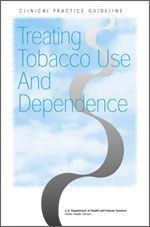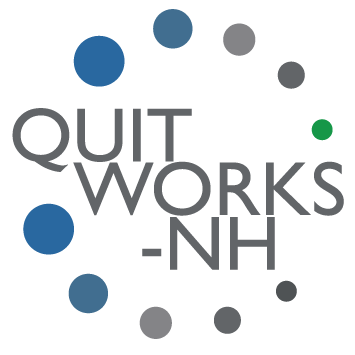The Evidence Base for QuitWorks-NH
 QuitWorks-NH offers five proven elements recommended in the U.S. Public Health Service-sponsored Clinical Practice Guideline:Treating Tobacco Use and Dependence and in the CDC-sponsored Guide to Community Preventive Services:
QuitWorks-NH offers five proven elements recommended in the U.S. Public Health Service-sponsored Clinical Practice Guideline:Treating Tobacco Use and Dependence and in the CDC-sponsored Guide to Community Preventive Services:
- Tools to identify people who use tobacco
- Prompts to guide providers to intervene with people who use tobacco and offer pharmacotherapy
- Proactive telephone counseling for people who use tobacco > 30 minutes
- Patient education materials
- Feedback reports to providers
 Systematic Identification of people who use tobacco
Systematic Identification of people who use tobacco
Adopting office systems to identify people who use tobacco and to prompt providers to intervene increases the delivery of tobacco treatment by clinicians. Based on a meta-analysis of studies evaluating the efficacy of office systems to identify people who use tobacco at each clinical encounter, the use of a screening system to identify smoking status was found to increase cessation rates. The QuitWorks-NH Materials provide tools needed to implement office-wide systems to ensure that, for every patient at every clinic visit, tobacco-use status is queried and documented.
 Brief Clinician Interventions: Two Options
Brief Clinician Interventions: Two Options
Clinical trials clearly demonstrate that brief smoking cessation counseling by physicians, dentists, and other clinicians significantly increases smoking cessation rates in adult patients.
Intervention #1: Directly refer your patient to QuitWorks-NH
Intervention #2: Give your patient encouragement to use 1-800-QUIT-NOW
|
These guidelines recommend the 5As Intervention, which is the gold standard for CDC’s Best Practices. Today the abbreviated 2As and R Intervention is widely accepted as an effective tobacco treatment intervention.
|
 Behavioral Counseling and Pharmacotherapy
Behavioral Counseling and Pharmacotherapy
The evidence documented in U.S. Public Health Service Clinical Practice Guideline showed that brief physician advice to quit improved patient cessation rates, and the addition of brief counseling (under three minutes) increased the cessation rates even more. A combination of counseling and pharmacotherapy produced the best results.
Behavioral counseling (including telephone-based services) and pharmacotherapy (nicotine gum, patch, nasal spray, lozenge and inhaler), the antidepressant bupropion (Zyban® or Wellbutrin SR®) or the nicotine receptor agonist varenicline (Chantix™) were found to be effective. A combination of counseling and pharmacotherapy produced the best results. Physician or clinician advice based on health issues provides a strong incentive for people who use tobacco to quit. QuitWorks-NH reinforces and enhances clinician efforts and supports successful quit attempts.
 Telephone Counseling Works
Telephone Counseling Works
The Public Health Service Clinical Practice Guideline recommends proactive telephone counseling, as treatments involving person-to-person contact (individual, group, or proactive telephone counseling) are consistently effective.
 Over 100 New Hampshire health care professionals refer to QuitWorks-NH regularly
Over 100 New Hampshire health care professionals refer to QuitWorks-NH regularly
Your system identifies patients as tobacco dependent…QuitWorks-NH does the rest. This intervention is at no cost to your patient and is billable through ICD-10 17.3 Tobacco.
- Up to six telephone counseling sessions from specially trained Quit Coaches
- Nicotine Replacement Therapy patches offered with medical screening (while supplies last)
- Mailing patient education materials
- Patient outcome reports sent to providers
QuitWorks-NH Results
 Who Uses QuitWorks – The New Hampshire Experience
Who Uses QuitWorks – The New Hampshire Experience
From the start of the QuitWorks-NH program in 2004, over 2,500 patients were referred through the QuitWorks-NH program. The following is a snapshot of the patient profile for QuitWorks-NH participants February 2010 – February 2012:
- 62% are women
- 59% have a high school education or less
- 49% are 45-64 years old
- 30% are 25-44 years old
- 6% are ethnic minorities
 QuitWorks-NH Patient Outcomes
QuitWorks-NH Patient Outcomes
All QuitWorks-NH patients who complete an intake with the QuitWorks-NH counselor receive a 6-month follow-up evaluation call from the Survey Team at John Snow, Inc. If reached, each patient participates in a brief interview to ascertain a) whether or not they had quit smoking, b) the number and duration of quit attempts made, c) services used which were provided by the Resource Center or which clients may have secured on their own, d) which services helped clients to quit smoking (including the use of nicotine replacement therapy) and e) client’s level of satisfaction with services delivered by the NH Quitline and their referring provider.
The NH Quitline offers counseling and web resources in addition to mailing clients self-help materials to assist them in their quit smoking attempts and maintenance of a quit.
| RELATED RESOURCES |
Refer Your Patients to a Quit Coach
Submit a Provider Web Referral or E-Referral through the EMR.
Choose the most convenient method for YOUR practice!
